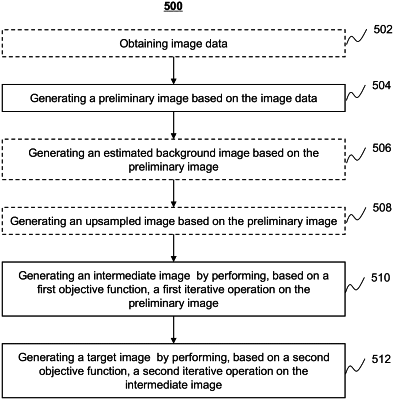| CPC G06T 5/10 (2013.01) [G06T 2207/10056 (2013.01); G06T 2207/10064 (2013.01); G06T 2207/30024 (2013.01)] | 20 Claims |

|
1. A method for image processing, implemented on at least one machine each of which has at least one processor and at least one storage device, comprising:
obtaining a preliminary image by filtering image data generated by an image acquisition device;
generating an estimated background image by performing an iterative wavelet transformation operation on the preliminary image, wherein the iterative wavelet transformation operation includes one or more iterations, and each current iteration comprises:
determining an input image based on the preliminary image or an estimated image generated in a previous iteration;
generating a decomposed image by performing a multilevel wavelet decomposition operation on the input image;
generating a transformed image by performing an inverse wavelet transformation operation on the decomposed image;
generating an updated transformed image based on the transformed image and the input image;
generating an estimated image for the current iteration by performing a cut-off operation on the updated transformed image; and
in response to determining that a termination condition is satisfied, designating the estimated image as the background image;
generating an intermediate image by performing, based on a first objective function, a first iterative operation on the preliminary image, wherein the first objective function associated with the estimated background image, the first iterative operation including sparse deconvolution of the intermediate image; and
generating a target image based on the intermediate image, wherein the target image has a resolution that extends beyond physical limits posed by the image acquisition device.
|